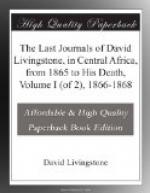Three sepoys played at groaning very vigorously outside my door; they had nothing the matter with them, except perhaps fatigue, which we all felt alike; as these fellows prevented my sleeping, I told them quite civilly that, if so ill that they required to groan, they had better move off a little way, as I could not sleep; they preferred the verandah, and at once forbore.
The abundance of grain and other food is accompanied by great numbers of rats or large mice, which play all manner of pranks by night; white ants have always to be guarded against likewise. Anyone who would find an antidote to drive them away would confer a blessing; the natural check is the driver ant, which when it visits a house is a great pest for a time, but it clears the others out.
FOOTNOTES:
[12] There is a double purpose in these murders; the terror inspired in the minds of the survivors spurs them on to endure the hardships of the march: the Portuese drivers are quite alive to the merits of this stimulus.—ED.
[13] A tribal distinction turns on the customs prevailing with respect to animal food, e.g. one tribe will eat the elephant, the next looks on such flesh as unclean, and so with other meat. The neighbouring Manganja gladly eat the leopard and hyaena.—ED.
[14] A coloured cloth manufactured expressly for barter in East Africa.
[15] This is pronounced “Y-yow.”—ED.
CHAPTER IV.
Geology and description of the Waiyau land. Leaves Mataka’s. The Nyumbo plant. Native iron-foundry. Blacksmiths. Makes for the Lake Nyassa. Delight at seeing the Lake once more. The Manganja or Nyassa tribe. Arab slave crossing. Unable to procure passage across. The Kungu fly. Fear of the English amongst slavers. Lake shore. Blue ink. Chitane changes colour. The Nsaka fish. Makalaose drinks beer. The Sanjika fish. London antiquities. Lake rivers. Mukate’s. Lake Pamalombe. Mponda’s. A slave gang. Wikatani discovers his relatives and remains.
28th July, 1866.—We proposed to start to-day, but Mataka said that he was not ready yet: the flour had to be ground, and he had given us no meat. He had sent plenty of cooked food almost every day. He asked if we would slaughter the ox he would give here, or take it on; we preferred to kill it at once. He came on the 28th with a good lot of flour for us, and men to guide us to Nyassa, telling us that this was Moembe, and his district extended all the way to the Lake: he would not send us to Losewa, as that place had lately been plundered and burned.




